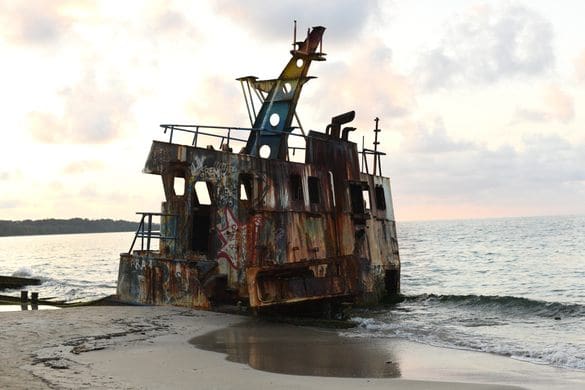The Yicel Shipwreck: A Hidden Gem in Manzanillo, Costa Rica
Nestled along the pristine Caribbean coast of Costa Rica, the small village of Manzanillo is a tropical paradise known for its stunning beaches, vibrant coral reefs, and lush rainforests. Among its many attractions, one stands out as a curious and intriguing landmark: the Yicel shipwreck. This half-buried cargo ship has become an iconic sight in Manzanillo, drawing both locals and tourists alike to its sandy resting place.
History of the Yicel Shipwreck
On December 8, 2017, the Yicel was sailing north along Costa Rica’s Caribbean coast when it began taking on water. Built-in 1961, the 135-foot-long ship was headed for the port of Limón to pick up cargo, but a hull failure halted its progress. Water began to enter through the cracks, and when the pumps failed, the crew could not remove the water. Rather than sink at sea, the captain made the decision to cross the reef and intentionally ground the vessel, and the Yicel ran up onto Playa Grande on the edge of the sleepy fishing village of Manzanillo, 40 nautical miles south of its intended destination.
The Panamanian captain and Colombian crew members escaped with no injuries, but the village had a ticking time bomb on its beach. While the vessel was empty of cargo, according to Costa Rica’s Ministry of Environment, it was still carrying 1,600 gallons of diesel fuel, plus a full tank of hydraulic oil. A leak would be devastating, not only to the fragile marine and jungle habitat but also to the community that derives its income from fishing and ecotourism.
Working with the cargo ship’s owners as well as the Maritime Ports Division, the Ministry of Environment checked the fuel lines for cracks and, finding none, used a system of pumps and bladders to offload all of the fuel. Despite the rough seas, the vessel was safely emptied 11 days after running aground.
Originally, the Costa Rican government planned to pump the water out of the boat and float it so it could be towed to port, but this plan never came to fruition. Today, the ship remains on the beach. Partially buried in the sand, it’s now a canvas for art and a destination for urban explorers.
A Striking Sight
The first thing visitors notice about the Yicel shipwreck is its imposing presence. The ship’s rusted hull, weathered by decades of exposure to the elements, rises dramatically from the sand. The once-functional cargo holds and decks are now a playground for the curious, offering a glimpse into the past. Barnacles and other marine life have made the ship their home, adding to the eerie beauty of the wreck.
Exploring the Wreck
For those adventurous enough to explore the Yicel up close, the experience can be quite thrilling. At low tide, it’s possible to walk right up to the ship and even venture inside its rusted compartments. However, caution is advised as the structure is old and unstable in places. Snorkelers and divers can also explore the submerged portions of the ship, where colorful fish and other sea creatures have created a vibrant underwater habitat.
Ecological Impact
The Yicel shipwreck has not only become a historical landmark but also an important part of the local ecosystem. The ship’s submerged sections provide a haven for marine life, contributing to the biodiversity of the area. Coral and other sea organisms have colonized the metal surfaces, turning the wreck into an artificial reef. This has helped support local fisheries and has become a popular spot for underwater photographers and marine biologists.
Visiting Manzanillo
Manzanillo itself is a charming village that offers a variety of activities for visitors. From its tranquil beaches and warm waters to the lush Gandoca-Manzanillo Wildlife Refuge, there’s no shortage of natural beauty to explore. The area is also rich in Afro-Caribbean culture, with vibrant music, delicious cuisine, and colorful festivals that give visitors a taste of local life.
Practical Information
To visit the Yicel shipwreck, travelers should aim to arrive during low tide for the best experience. The village of Manzanillo is accessible by road and is located about 12 kilometers south of Puerto Viejo de Talamanca. There are several accommodations in the area, ranging from budget-friendly hostels to more luxurious lodges. Local guides are available to provide tours of the shipwreck and other attractions in the region.
Preservation and Respect
While the Yicel shipwreck is a fascinating site to explore, it’s important for visitors to remember to treat it with respect. The ship is part of the local heritage and ecosystem, and care should be taken to preserve its condition. Visitors are encouraged to leave no trace, avoiding the removal of any artifacts or marine life.
Know Before You Go
The wreck of the Yicel is accessible from the beach, making it easy for visitors to experience this unique landmark. However, always check local tide schedules and weather conditions before planning your visit to ensure a safe and enjoyable experience.
The Yicel shipwreck in Manzanillo, Costa Rica, stands as a testament to the region’s maritime history and natural beauty. This half-buried cargo ship, with its rusted hull and submerged sections, offers a unique and memorable experience for those who venture to this picturesque part of the Caribbean coast. Whether you’re a history buff, an avid snorkeler, or simply someone looking for a bit of adventure, the Yicel shipwreck is a must-see destination that encapsulates the charm and allure of Manzanillo. #howlermag #howlermagazine






